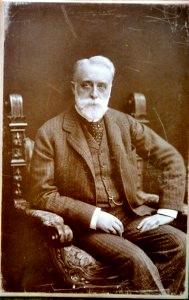Robert Suermondt
Robert Friedrich Suermondt (born November 24, 1844 in Aachen ; † May 25, 1919 there ) was a German private banker and entrepreneur.
Live and act
Robert Suermondt was the third son of the entrepreneur and art patron Barthold Suermondt and Amalie Luise Cockerill, daughter of the steel and mining entrepreneur James Cockerill . His other brothers included the entrepreneur William Suermondt , the stud owner Henry Suermondt and his half-brother, the successful gentleman rider Otto Suermondt .
After his commercial and banking training in the private bank founded by his father in 1847 and after several years of professional experience in various companies, Robert Suermondt decided to found his own banking company in 1867 at the age of 23 under the name Bankhaus Robert Suermondt & Cie . He himself was a personally liable partner and his father was involved with a large investment as a limited partner . The bank primarily served to supply capital to Aachen spinning and weaving mills, but also invested in international companies. For example, when the Rheinische Stahlwerke was founded in 1870 , the bank was involved with 100 shares out of a total of 2,000 shares, with a further 860 shares coming from the bank owned by Barthold Suermondt, his father. The bank was also one of the main financiers of the soda factory in Inowrocław (Hohensalza) in Poland, founded by his brother William Suermondt , which then traded under the name “Chemische Fabrik Robert Suermondt & Co Montwy” and was sold to the Belgian Solvay group in 1907 and is currently under the name "Inowrocławskie Zakłady Chemiczne Soda Matwy" still exists.
After Robert Suermondt had the monumental banking house Suermondt, designed by the well-known Aachen architect Eduard Linse , built on Theaterstrasse in Aachen in 1900 , the banking house Robert had to be built one year later, on October 22, 1901, in the year the building was completed Suermondt & Cie. the liquidation request. Suermondt then transferred his bank to Bergisch-Märkische Bank , which in turn was integrated into Deutsche Bank in 1914 .
In addition to managing his bank, Robert Suermondt was also active in various executive bodies. From 1887, after the death of his father, he took over his seat on the supervisory board of Rheinische Stahlwerke and from 1911 to 1919 also chaired it. Also from 1887, Robert Suermondt continued the negotiations his father had begun with the southern Russian government in order to follow up the steel works in Praga near Warsaw (Towarzystwo Warzawskiej Fabryki Stali) founded in 1877/1878 by the Rheinische Stahlwerke, Cockerill-Sambre in Seraing and Robert's father-in-law Wilhelm Rau Relocating to Russia after they suffered from sales difficulties due to Russian customs policy. Finally, Robert Suermondt, together with the representatives of the companies mentioned, played a key role in the creation of the “South Russian Dnieprower Metallurgical Society” (Métallurgique Dniéprovienne du Midi de la Russie) in 1888 with a capital of 5 million rubles. The headquarters of the administration were in St. Petersburg and the shares were initially traded on the Warsaw Stock Exchange, and from 1912 on the Petersburg Stock Exchange. The steelworks and the manganese ore mines, like the iron mines, were located in Verkhivtseve , in the Yekaterinoslav governorate , the coal mines in the Slovianoserbsk and Bachmut districts of the same governorate, and thus all of the company's areas of what is now Ukraine . Robert Suermondt was part of the administration of the new company and his signatures can be found on most of the company's shares.
Despite the many foreign assignments, Robert Suermondt was accepted into the first supervisory board of the Association for Hard Coal Construction in the Wurmrevier after its reorganization on October 26, 1897. In addition, he was elected chairman of the supervisory board of AachenMünchener -Versicherungs AG in April 1915 and changed to the post of deputy from 1918. Suermondt had also been a member of Club Aachener Casino since 1867 , which he headed from 1908 to 1912 and again in 1914 as chairman. In addition, he financially supported the publication of the General Lexicon of Fine Artists from Antiquity to the Present by Thieme-Becker
Robert Suermondt was married to Fanny Maria Rau (1856–1930), daughter of the Warsaw entrepreneur and head of the iron and non-ferrous metal foundry "Lilpop, Rau & Loewenstein" Wilhelm E. Rau, founded in 1818. The Suermondt couple had only one son, Herbert Barthold Wilhelm Suermondt (* 1886). They found their final resting place in the family crypt in Aachen's Westfriedhof .
Literature and Sources
- Clemens Bruckner: On the economic history of the administrative district of Aachen . Rheinisch Westfälisches Wirtschaftsarchiv zu Cologne, 1967, pp. 232, 233, 497, 498
- Eduard Arens, Wilhelm Leopold Janssen : Club Aachener Casino , new ed. by Elisabeth Janssen and Felix Kuetgens , Druck Metz, Aachen 2nd edition 1964, pp. 266/267
Web links
Individual evidence
- ^ List of the draftsmen of the private subsidy for the artist lexicon in the general lexicon of fine artists from antiquity to the present
| personal data | |
|---|---|
| SURNAME | Suermondt, Robert |
| ALTERNATIVE NAMES | Suermondt, Robert Friedrich (full name) |
| BRIEF DESCRIPTION | German private banker and entrepreneur |
| DATE OF BIRTH | November 24, 1844 |
| PLACE OF BIRTH | Aachen |
| DATE OF DEATH | May 25, 1919 |
| Place of death | Aachen |


